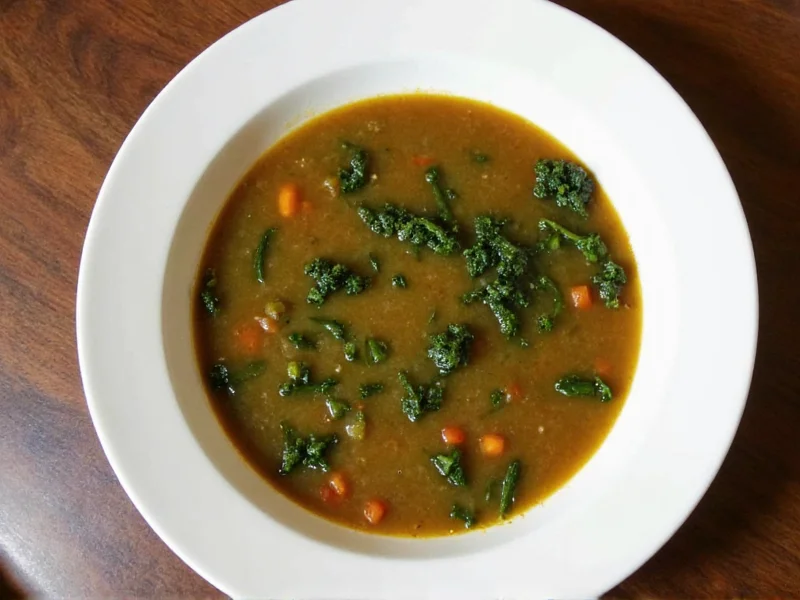Originating as a frugal meal for Tuscan farmers, this soup transforms simple pantry staples into a deeply flavorful dish. The name ribollita literally means "reboiled," reflecting its traditional preparation method where leftover soup was reheated daily, allowing flavors to intensify with each warming.
Essential Ingredients for Authentic Tuscan Kale Soup
Creating an authentic tuscan kale soup recipe requires specific ingredients that define its character. Unlike standard kale varieties, lacinato kale (also called dinosaur kale or cavolo nero) provides the proper texture and flavor. Its dark, wrinkled leaves hold up well during cooking without becoming mushy.
| Core Ingredients | Why It Matters | Substitution Options |
|---|---|---|
| Lacinato (Tuscan) kale | Provides authentic earthy flavor and proper texture | Curly kale (use 25% less) |
| Cannellini beans | Creates creamy texture when partially mashed | Gigante or Great Northern beans |
| Stale rustic bread | Thickens soup naturally (traditional ribollita method) | None - essential for authenticity |
| Extra virgin olive oil | Provides fruity base note essential to Tuscan cuisine | None - use high-quality Tuscan or Ligurian oil |
Step-by-Step Preparation Guide
Follow these steps for an easy tuscan kale soup for beginners that remains authentic to its Italian roots:
- Prepare vegetables: Finely dice 1 onion, 2 carrots, and 2 celery stalks (the classic soffritto). Remove tough stems from 1 large bunch lacinato kale and chop leaves.
- Sauté base: Heat 3 tablespoons extra virgin olive oil over medium heat. Cook soffritto until translucent (8-10 minutes), stirring frequently to prevent browning.
- Add tomatoes and beans: Stir in 28oz crushed tomatoes and 2 cans rinsed cannellini beans. Simmer 15 minutes to develop flavors.
- Incorporate kale: Add chopped kale in batches, stirring until wilted. This healthy tuscan kale soup with white beans requires complete kale integration.
- Thicken with bread: Layer 4-6oz stale rustic bread (like ciabatta) between soup portions. Let sit 10 minutes before serving to achieve proper ribollita consistency.
- Final seasoning: Adjust salt, add black pepper, and finish with generous drizzle of raw olive oil.
Perfecting Your Tuscan Kale Soup Technique
Achieving restaurant-quality results at home requires attention to these critical details:
- Don't rush the soffritto: Properly cooked base vegetables (without browning) create the soup's flavor foundation. This step takes 10-12 minutes on medium-low heat.
- Kale preparation matters: Remove the tough central rib from each kale leaf before chopping. This prevents unpleasant stringy textures in your traditional tuscan kale soup.
- Acidity balance: If tomatoes taste too sharp, add 1 teaspoon sugar or a Parmesan rind while simmering to mellow flavors.
- Resting time: Authentic ribollita improves overnight. Refrigerate and reheat gently the next day for deeper flavor development.
Variations for Different Dietary Needs
While purists might scoff, these thoughtful adaptations maintain the soup's essence while accommodating various preferences:
Vegetarian and Vegan Options
The vegetarian tuscan kale soup recipe is naturally meat-free. For vegan preparation, ensure no cheese is added during cooking (though a Parmesan rind for simmering is traditional). Substitute with kombu seaweed for umami depth.
Meat-Enhanced Version
For non-vegetarian preparation, add 4oz diced pancetta with the soffritto. Alternatively, include a smoked ham hock during simmering for subtle meatiness without overpowering the vegetables.
Tuscan kale soup without sausage adaptation
Many Americanized versions include sausage, but authentic ribollita contains no meat. If avoiding sausage while wanting protein richness, increase beans to 3 cans and add 2 tablespoons nutritional yeast.
Nutritional Profile and Health Benefits
This healthy tuscan kale soup delivers impressive nutritional value per serving (1.5 cups):
- Fiber: 12g (43% daily value) from kale, beans, and whole grain bread
- Vitamin K: 680% DV from lacinato kale
- Plant-based protein: 14g from cannellini beans
- Low calorie: Approximately 280 calories per serving
- Rich in antioxidants: Lutein and beta-carotene from dark leafy greens
The combination of fiber-rich vegetables and legumes creates sustained energy release, making this tuscan kale soup for weight loss an excellent choice for balanced nutrition. The olive oil provides heart-healthy monounsaturated fats that enhance absorption of fat-soluble vitamins.
Serving and Storage Recommendations
For optimal enjoyment of your tuscan kale soup cooking time investment:
- Serving temperature: Serve hot but not boiling (165°F/74°C) to preserve delicate olive oil flavors
- Traditional accompaniment: Drizzle with raw olive oil and sprinkle with freshly cracked black pepper
- Best kale for tuscan soup note: Lacinato kale becomes more tender upon reheating, improving texture the next day
- Storage: Keep in airtight container for up to 5 days in refrigerator
- Freezing: Freeze without bread for up to 3 months; add fresh bread when reheating
- Reheating: Warm gently over medium-low heat, adding water or broth if too thick
Common Mistakes to Avoid
Even experienced cooks make these errors when preparing tuscan kale soup from scratch:
- Using curly kale instead of lacinato: Curly kale's texture differs significantly and requires adjustment in quantity
- Overcooking the kale: Add kale near the end to maintain texture and vibrant color
- Skipping the bread: The stale bread isn't optional in authentic ribollita—it's essential for proper consistency
- Insufficient seasoning: Kale requires more salt than other greens; season in layers throughout cooking
- Serving immediately: Authentic ribollita requires at least 4 hours resting time for flavors to meld
Final Thoughts on Perfecting Your Tuscan Kale Soup
Mastering this tuscan kale soup storage tips friendly dish connects you to centuries of Italian culinary tradition. The beauty of ribollita lies in its adaptability—while maintaining core elements, home cooks can adjust ingredients based on seasonal availability and personal preferences. Remember that the soup's character develops over time, making it an ideal make-ahead meal that improves with each reheating, just as Tuscan farmers discovered generations ago.











 浙公网安备
33010002000092号
浙公网安备
33010002000092号 浙B2-20120091-4
浙B2-20120091-4